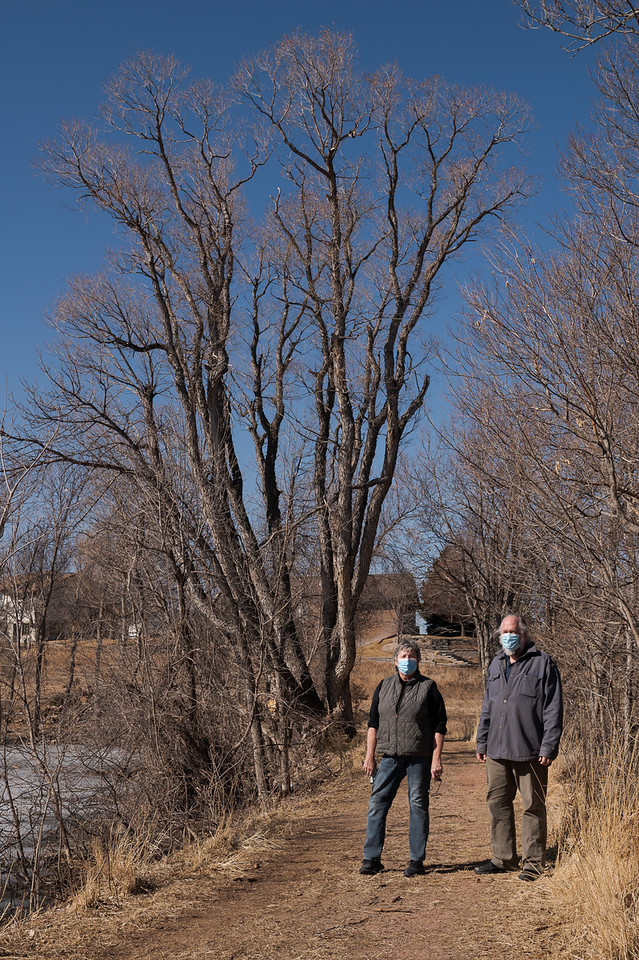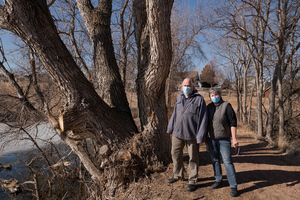Briggs Pond clean up reveals possible state champion tree

CHADRON – A recent project aimed at removing Russian olive trees from the area around Briggs Pond southwest of the Chadron State College campus unexpectedly revealed the presence of a possible Nebraska State Champion Tree on the Chadron State Foundation’s 50 acre-plus Thompson Natural History Preserve.
CSC grounds and maintenance workers spent about six weeks in late 2020 working to remove thick stands of Russian olive, an invasive, weedy tree that crowds out desirable native plant species, said Lucinda Mays, CSC horticulturist. Workers also removed deadfall and other storm damage in treed areas around the two ponds, which are fed by runoff and overflow from the Chadron water treatment plant.
The work opened up the view into areas that had been hidden by thick brush, making the beauty of the ponds more immediately apparent, said Mays, and disclosing the presence of plants that she had not realized were present.
One tree species in particular, a peachleaf willow (Salix Amygdaloides), stood out to Mays.
“While peachleaf willows aren’t rare, most of us just hadn’t seen these tall trees for all the brush,” she said.
After measuring one of the willow’s height (50 feet) and girth (about 23.25 feet), and checking state records, Mays concluded it might qualify as the largest of its kind in the state. An application for State Champion Tree status is pending verification by the Nebraska Forest Service.
A state champion Colorado blue spruce tree that stood 75 feet tall was removed from the Dean’s Green in 2014 because of its age and deteriorated condition.
The willow, a species native to Nebraska, was likely a volunteer, not planted deliberately by humans, but thriving in an area where moisture is plentiful, Mays said. Thinning the Russian olives will increase the diversity of native species like the willow and benefit the area’s wildlife, she said. Removing brush that had obscured views of the ponds was another benefit, said Mays.
“It was a thrill to see the views opened up so we could see the water,” she said.
The Harold and LaVerne Thompson Natural Preserve was established in 1974 through a $40,000 gift to the Chadron State Foundation. It has become a popular outdoor recreation area for students and Chadron citizens. A concrete paved trail through the preserve, created in 2004 with a transportation enhancement grant from the Nebraska Department of Roads, gets extensive use by hikers, runners, and cyclists.
Recently, a collaboration of CSC students, faculty, staff and community members created a labyrinth in the remains of an old water tank on a high point on the property.
While a comprehensive survey of the preserve’s plant and animal communities has never taken place, Steve Rolfsmeier, director of the High Plains Herbarium, keeps a list of plants identified in various parts of the campus and the preserve. In 2018 students in Dr. Teresa Frink’s wildlife research class used acoustic monitoring devices to identify species of bats utilizing the area. Trail users have reported seeing owls, fox, deer, snakes, and turtles in the preserve, and deer are often seen in the area and on campus.
Work in the preserve won’t end with one season’s thinning. While some desirable plants that had been crowded out will likely produce a flush of growth this spring and summer, the remaining stumps of Russian olives and many weeds will sprout as well, and will have to be treated or removed, said Mays.
“There’s quite a seed bank on the ground, just waiting to sprout,” she said.
The thinning project may be just the first part of work on the preserve, said Ben Watson, CEO of the Chadron State Foundation.
“Like most people who have spent time on the trails or looked at the water resources of Briggs Pond, I’ve daydreamed about the potential for development of the preserve as an educational asset to Chadron State, and opportunities to benefit the campus and local community,” Watson said. “We don’t want to lose the momentum started with the thinning and have started engaging stakeholders about what the future of the preserve could look like.”
—George Ledbetter
Category: Campus News

